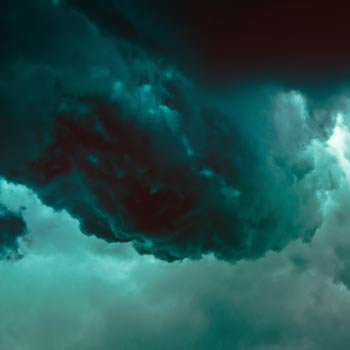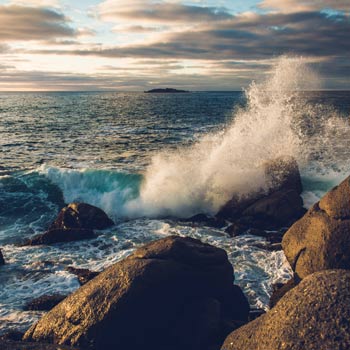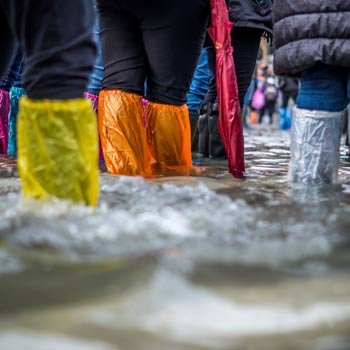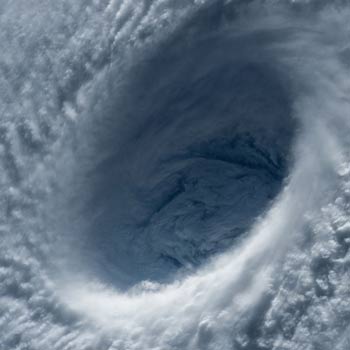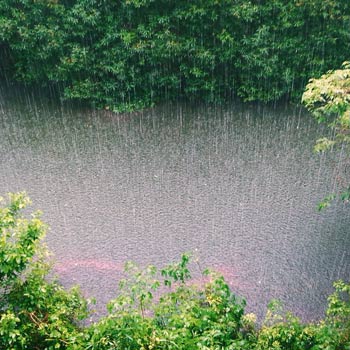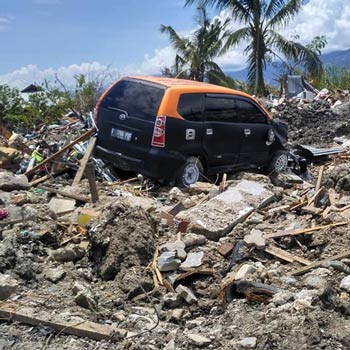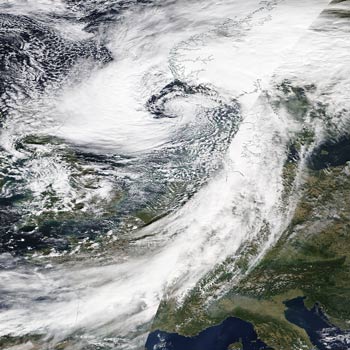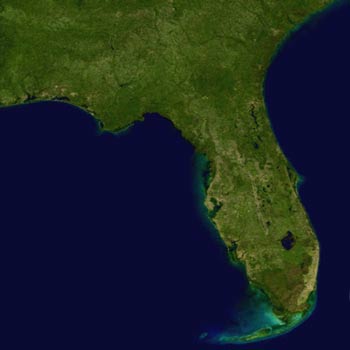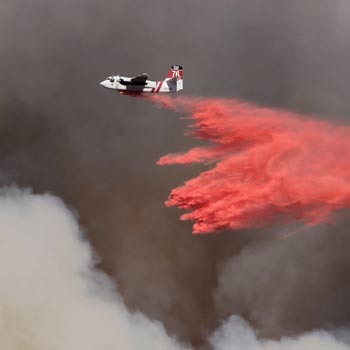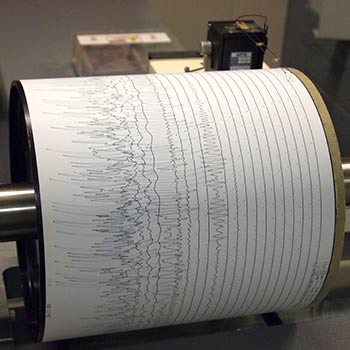1) Hurricane that occurs during a terrorist attack
2) Winter storm with high winds that reach a certain decibel level
3) North Atlantic cyclone that rapidly intensifies
Correct answer: 3. A “bomb cyclone” is one that undergoes bombogenesis, which is what happens when the atmospheric pressure associated with a midlatitude North Atlantic cyclone drops 24 millibars (mb) or more in the space of 24 hours. The lower the atmospheric pressure within a cyclone, the more intense the storm created. This kind of dramatic drop and rapid intensification can occur when a cold air mass collides with a warm air mass, such as might be found over warm ocean waters. The January 2018 blizzard that struck the U.S. East Coast fell 53 mb in the space of 21 hours.
4) Powerful type of cyclone that affects India every year
1) Coastal pollution caused by agricultural runoff into rivers
2) Conditions enabling a tropical cyclone to intensify after landfall rather than weaken
Correct answer: 2. In a warm environment, such as the deserts of Western Australia, wet soils can harbor a surprising amount of latent heat. Under the right conditions this can fuel tropical cyclone development just as effectively as warm seas, albeit briefly.
3) A warning sign of an approaching tsunami as the sea retreats
4) Factors inhibiting the intensification of cyclones in northern latitudes
1) A seasonal spike in storm surge
2) Coastal flooding at high tide unrelated to storms
Correct answer: 2. Sunny Day Flooding is the temporary nuisance inundation of low-lying coastal areas, especially streets. It occurs particularly during exceptionally high tide events and is exacerbated by rising sea levels.
3) Riverine flooding belatedly following inundation
4) A rarely experienced level of flooding in Scotland
1) Cimaron
2) Jebi
3) Jongdari
4) Trami
5) Mangkhut
Correct answer: 5. Typhoon Jongdari made landfall in Mie Prefecture on the island of Honshu on July 28; Typhoon Cimaron made landfall in southeast Tokushima Prefecture on August 23; Typhoon Jebi made its first landfall in Japan’s westernmost island of Shikoku on September 4 and a second landfall shortly afterward on the island of Honshu by the city of Kobe; and Typhoon Trami made landfall near Tanabe City in Wakayama Prefecture on September 30. Typhoon Mangkhut made landfalls in northern Luzon, Philippines, on September 14 and in Taishan, Guangdong Province, China, on September 16. September 26, 2018, marked the 60th anniversary of Super Typhoon Ida, one of Japan’s most devastating precipitation-induced flood disasters.
1) Harvey
2) Lane
Correct answer: 2. Hurricane Lane set a record in late August for most rainfall ever recorded from a tropical cyclone in the State of Hawaii. While Lane did not make landfall, it dumped 52.02 inches of rain, edging out the record of 52.00 inches made by Hurricane Hiki in 1950. But Lane’s rainfall this year is second to Hurricane Harvey’s U.S. record rainfall of 60.58 inches in Texas last year. Neither Michael nor Gordon broke rainfall records. In mid-September during Hurricane Florence, a reporting station in Swansboro, North Carolina, measured 34 inches of rain and another in Elizabethtown, North Carolina, measured 35.93 inches, breaking the North Carolina record set by Hurricane Floyd in September 1999 of 24.06 inches.
3) Michael
4) Gordon
1) M6.5 in northern Sumatra
2) M6.1 in Aceh province
3) M7.5 near Palu in central Sulawesi
Correct answer: 3. The September 28 M7.5 Palu earthquake likely occurred due to slip on the fast slipping, predominantly strike-slip, NNW trending, Palu-Koro fault at the western boundary of the North Sula block, which forms part of the complex triple junction at the intersection of the Australian, Philippine, and Sunda plates. The proximity of the city to the fault and to the ocean meant that its residents not only had to deal with shaking but also the subsequent tsunami. (The M6.5 Northern Sumatra earthquake struck on December 7, 2016, local time; the M6.1 Aceh earthquake struck on July 2, 2013; and the M8.6 off the west coast of northern Sumatra struck on April 11, 2012.)
4) M8.6 off the west coast of northern Sumatra
1) 0
2) 1
3) 2
4) 3
Correct answer: 4. This year Storm Ali struck on September 19 with wind gusts up to 164 km/h (102 mph) and heavy rain impacting Northern Ireland, Scotland, northern England, and parts of northern Wales. Bronaugh came in Ali’s wake, bringing wind gusts up to 143 km/h (89 mph) and heavy rain that ultimately led to widespread flooding in the UK. Then Fabienne devastated parts of southern and central Germany before moving into Switzerland with wind gusts up to 158 km/h (98 mph). Having three named storms in September is abnormal in comparison to years past. In 2017, there was just one named storm in the month and in the 2016 and 2015 seasons, there were none.
1) Category 2 (sustained winds of 96-110 mph)
2) Category 3 (sustained winds of 111-129 mph)
Correct answer: 2. The 1917 unnamed storm #4 and hurricanes Opal 1995, Ivan 2004 (an Alabama landfall that impacted Florida), and Dennis 2005 all made landfall as Category 3 storms west of Hurricane Michael’s historic landfall.
3) Category 4 (sustained winds of 130-156 mph)
4) Category 5 (sustained winds of 157 or higher)
1) Carr Fire in July 2018
2) Cedar Fire in October 2003
3) Thomas Fire in December 2017
4) Tubbs Fire in October 2017
Correct answer: 4. The Tubbs Fire in October 2017 affected Napa and Sonoma counties in California, destroying 5,636 structures. The Camp Fire, which started on November 8 this year, burned more than three times the number of structures before being fully contained; it is also the deadliest fire ever recorded in California. The Carr Fire burned in July this year, affecting Shasta and Trinity counties and destroying 1,604 structures. The Cedar Fire of 2003 is now the third largest and third most destructive wildfire in California’s recorded history. The Thomas Fire in December 2017 was the largest California wildfire ever recorded until the Mendocino Complex Fire burned in July 2018. Neither fire made the top 10 in terms of structures destroyed because the biggest wildfires are not always the most destructive.
1) Leading IT service providers
2) Internet infrastructure
3) Common vulnerabilities
4) All of the above
Correct answer: 4. All of the above. These sources of systemic cyber risk aren’t mutually exclusive, which can lead to unexpected losses for cyber insurers with unclear policy wording regarding the failure or compromise of these sources of risk. In addition, unlike natural disasters—whose risk is correlated by easily verifiable geographic location—systemic cyber risk aggregates itself around sources like these, which are more challenging to understand.
1) 2 times
2) 3 times
3) 10 times
4) 100 times
5) 1,000 times
Correct answer: 5. To convey the huge range of earthquake ground motions and energy experienced, the Richter magnitude is defined as a base-10 logarithmic scale of the amplitude of the peak ground displacement and scaled by an arbitrary reference displacement for magnitude zero earthquakes. What this means in plain English is that each point on the scale marks shaking with an amplitude 10 times bigger than the point below it.
2018 Year-in-Review Quiz Results
Your score:

